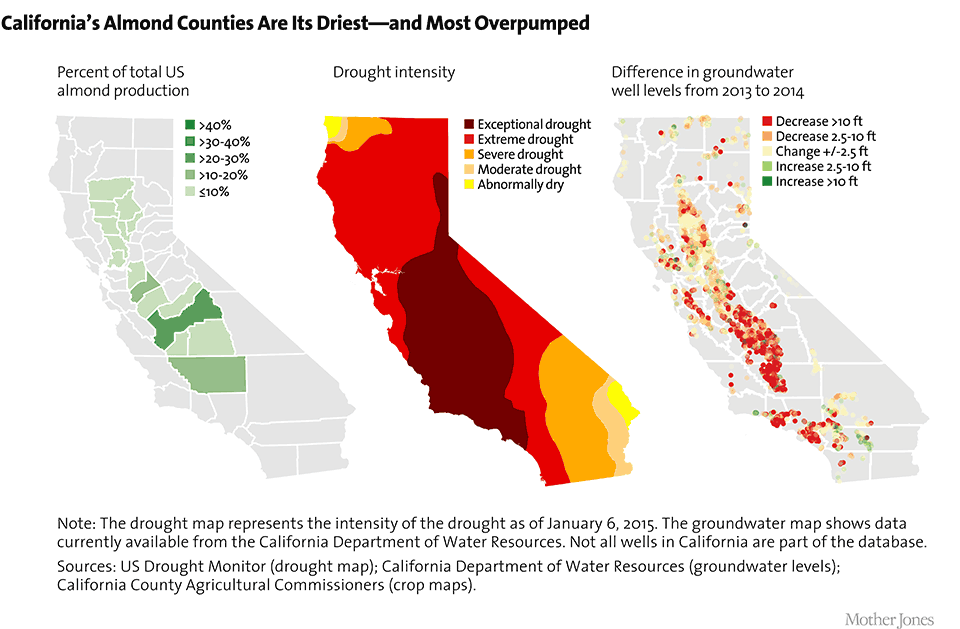
Each almond takes a gallon of water to produce; so why increase almond production when almonds are a crop that uses much more water than grapes or other fruits and vegetables? Supply and demand.
Almond orchards require about a third more water per acre than grape vineyards. In fact, they're one of California's thirstiest crops. It takes a gallon of water to produce a single almond—more than three times the amount required for a grape and two and a half times as much for a strawberry. There's more water embedded in just four almonds than there is in a full head of lettuce. But unlike row crops, which farmers can choose not to plant during dry spells, almond trees must be watered no matter what. In the midst of the worst drought in California's history, you might expect almonds' extreme thirst to be a deal breaker. But it's not. In fact, the drought has had hardly any impact at all on the almond boom. The state's farmers bought at least 8.33 million young almond trees between July 2013 and July 2014, a 25 percent increase from the previous year. About a quarter of the saplings went to replace old orchards, but most of the rest were new plantings, some 48,000 acres' worth, an area equal to three Manhattans.
Nut production is a big business that even Wall Street firms are involved in. But the big firms are able to keep California from instituting the kind of groundwater usage restrictions common in other states. So eventually over production will lead to the loss of farmland in this area. Everyone knows it but the short run returns to investment in nut production overweight the long term consequences.
Perfect competition or market failure?
First off, this is a very interesting article. I had no idea that so much water was needed to produce an almond crop. Second, I think I would define this situation as an instance of market failure because there are certain factors that are economically not ideal that will result in a lack of market equilibrium. The natural environmental factors that will be damaging to the supply of almonds means that demand will not be met.
ReplyDeleteI do think that this situation is a market failure because it is not sustainable at all.
ReplyDeleteAlso, glad to know the fascinating fact about almond vs other veggies.
This is a neat article, I remember watching a special on 60 Minutes showing how far California farmers were going to drill for water. This to me is a clear market failure. There is a better way that this market could function without such the drastic effect of depleting California of its water resources.
ReplyDeleteI found this article extremely interesting as well. Who knew almonds take so much water to harvest? I believe that this is a market failure, though. Yes there is high demand for almonds right now, but the damage this is causing to the land and the water supply will have negative effects on markets in the future. In the short run producing almonds may seem like a great idea, but in the long run I cannot agree.
ReplyDeleteI remember reading this article a while back since many people who are health conscious or non-supporters of GMO products or just lactose intolerant (I am in this last group) have been demanding Almond milk as an alternative to normal milk.
ReplyDeleteIt is very interesting to see that this market, besides being driven by lactose intolerant human beings like myself, is significantly more driven by the demand in China.
There probably should be some legislation in place to restrict almond/nut plantation . That way the price of almond would increases and the demand would decrease.
the water problem that California is having is definitely a market failure.
Interesting article. This seems like a market failure to me. The extra water being used to grow almonds could be put to a more efficient use that would benefit more people. I feel that this is a situation where government regulations are necessary.
ReplyDeleteThis is a market failure. With almonds being a thirsty crop, there will be less access to water and land in the long run. All the extra water used to grow almonds could be use more efficiently in growing other crops. It will be interesting to know about the restrictions that are taken against this situation.
ReplyDeleteThis is a really interesting article as everyone else has stated. I was not aware of how much water it took in order to grow almonds. I would have to agree with everybody prior that this is a market failure because although the short-term return on investment is high by not focusing at all on the long term I feel as though it will cost this market in the future. Also, growing a water thirsty crop during a time of drought seems to be a bit outrageous.
ReplyDeleteWatering almond plants - which require large amounts of water - seems very ridiculous, especially during a drought. Definitely a market failure like all the above comments have stated since a scare resource (i.e. water) is being used in an unsustainable manner. Interesting article but this use of water, time and money seems unreasonable.
ReplyDelete